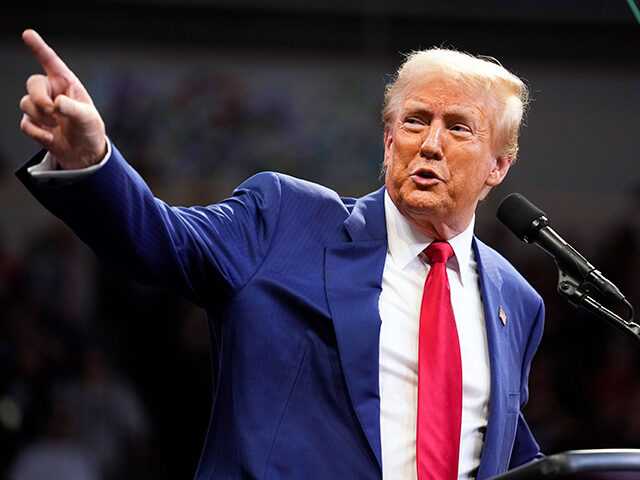Donald Trump is taking a political risk by centering migration — not the nation’s economy — in his two-week dash to the ballot box, says the New York Times.
“In the final weeks of a campaign …. Mr. Trump is going with his gut, doubling down on the rhetoric that he believes won him the 2016 election and using immigration and the border to form the core of his closing message to voters,” the newspaper reported October 19.
Migration ‘“beats out the economy” with voters, Donald Trump told his October 15 rally, the newspaper said. “It’s not even close.”
Immigration and the economy are wrapped together, Trump’s campaign told the newspaper:
Asked to explain Mr. Trump’s focus in the closing days of the race, a Trump spokesman, Brian Hughes, said: “President Trump rightfully recognizes that Kamala Harris’s porous border is at the heart of so many issues, whether it is high housing prices, low wages or overwhelmed hospitals and schools. An open border means that taxpayer dollars are wasted on illegal immigrants, instead of benefiting citizens. President Trump’s closing message is all about putting Americans first and restoring prosperity.”
The Times reporters did not mention that Kamala Harris’ 2024 economic platform requires a huge inflow of migrants. A Democratic-leaning advocacy group, for example, predicted she will import 12.3 million migrants during the next four years.
Amazingly, Harris has not tried to revive her campaign with a promise to reduce the inflow of economic migrants, despite her promising to upgrade border security many times.
A growing number of GOP leaders — including Trump’s pick for Vice President, JD Vance — recognize that the federal migration policy imposes huge pocketbook and civic costs on ordinary Americans.
Sen. Marco Rubio (R-FL), for example, wrote an October 17 article for CompactMag.com, showing that migration has damaged ordinary Americans:
… immigration remained within sustainable limits through most of the 1970s and ’80s, and it remained within most Americans’ grasp to make ends meet. My own parents, themselves immigrants from Cuba, earned enough to buy a home and raise four children on the salaries of a hotel bartender and stay-at-home mom who occasionally worked as a maid. As recently as 1985, meanwhile, the average US-born man could afford a middle-class lifestyle for a family of four on about 40 weeks of wages (compared with about 62 weeks today). In other words, the American Dream was alive and well, for immigrants and natives alike.
But Washington, DC, changed the rules for ordinary Americans by supercharging global trade and migration, Rubio wrote:
The consequences of this for US-born men have been catastrophic. The percentage of prime-age men now working or looking for work is close to what it was in 1940, in the throes of the Great Depression. Meanwhile, one economist estimates that by 2016, immigrants had “increased the size of the low-skilled workforce by roughly 25 percent.”
The Biden-Harris administration has only compounded the problem. By one government count, the administration has admitted at least 6.5 million more illegal migrants since then—and that doesn’t include an estimated 1.5 million “gotaways.”
Some Wall Street investors are touting an alternative, low-migration strategy that would expand economic growth and prosperity.
“I can argue, in the developed countries, the big winners are the countries that have shrinking populations,” BlackRock founder Larry Fink said at a pro-globalist event hosted by the World Economic Forum in Saudi Arabia. He continued:
That’s something that most people never talked about. We always used to think [a] shrinking population is a cause for negative [economic] growth. But in my conversations with the leadership of these large, developed countries [such as China, and Japan] that have xenophobic anti-immigration policies, they don’t allow anybody to come in — [so they have] shrinking demographics — these countries will rapidly develop robotics and AI and technology …
If a promise of all that transforms productivity, which most of us think it will [emphasis added] — we’ll be able to elevate the standard living in countries, the standard of living for individuals, even with shrinking populations.
In contrast, countries with expanding populations need to focus on basic issues of education and the “rule of law,” said Fink, adding:
So for those countries that have rising populations, the answer will be education … [and] for those countries that do not have a foundation of rule of law, or education, that’s where the [economic] divide is going to get more and more extreme.
Breitbart News has closely c0vered the federal government’s post-1990 use of migration to boost the U.S. consumer economy by extracting cheap workers, government-aided consumers, and apartment-sharing renters from poor countries.
Extraction Migration
Since at least 1990, the federal government has quietly adopted a policy of Extraction Migration to grow the consumer economy after Congress voted to help investors move the high-wage manufacturing sector to lower-wage countries.
The migration policy extracts vast amounts of human resources from needy countries. The additional workers, white-collar graduates, consumers, and renters push up stock values by shrinking Americans’ wages, subsidizing low-productivity companies, boosting rents, and spiking real estate prices.
The little-recognized economic policy has loosened the economic and civic feedback signals that animate a stable economy and democracy. It has pushed many native-born Americans out of careers in a wide variety of business sectors, reduced Americans’ productivity and political clout, slowed high-tech innovation, shrunk trade, crippled civic solidarity, and incentivized government officials and progressives to ignore the rising death rate of discarded, low-status Americans.
Donald Trump’s campaign team recognizes the economic impact of migration. Biden’s unpopular policy is “flooding America’s labor pool with millions of low-wage illegal migrants who are directly attacking the wages and opportunities of hard-working Americans,” said a May statement from Trump’s campaign.
The secretive economic policy also sucks jobs and wealth from heartland states by subsidizing coastal investors and government agencies with a flood of low-wage workers, high-occupancy renters, and government-aided consumers. Similar policies have damaged citizens and economies in Canada and the United Kingdom.
The colonialism-like policy has also damaged small nations and has killed hundreds of Americans and thousands of migrants, including many on the taxpayer-funded jungle trail through the Darien Gap in Panama.




